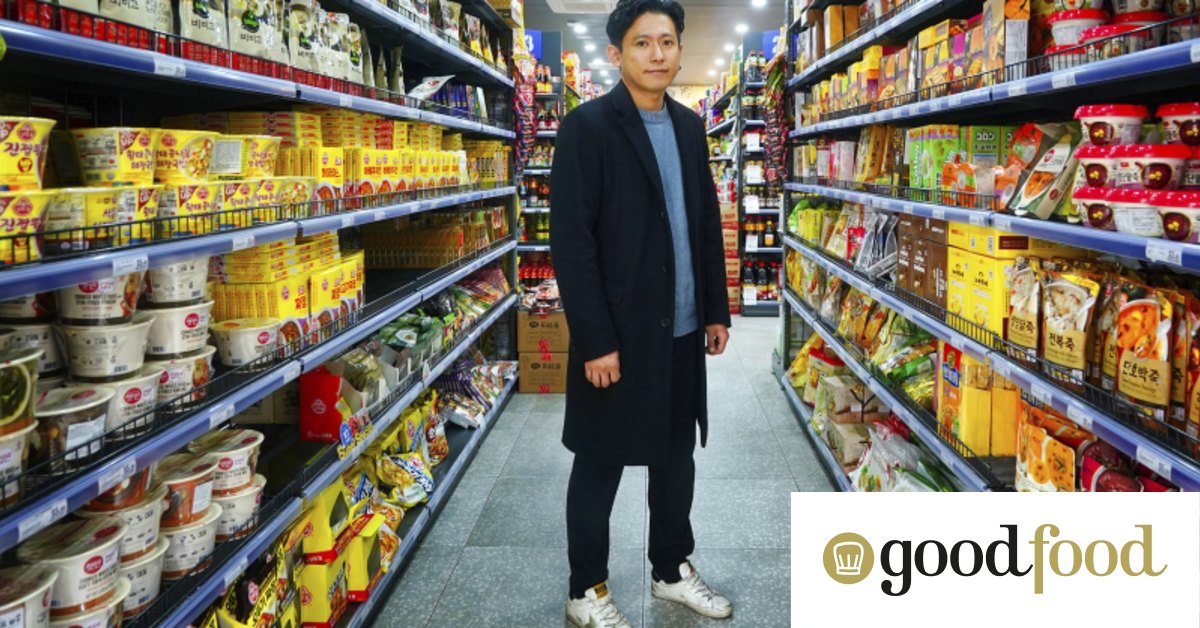It’s tough not to bust out some dance moves as K-pop blasts through the speakers at KT Mart, the Asian superstore billed as “Korea Town in Melbourne”, opposite Queen Vic Market.
I’m here with Mika Chae, South Korean chef and owner of Doju, a Korean fusion fine-diner that’s riding Melbourne’s current K-wave, and we’re on the hunt for his ingredient hit list.
“Are people scared of Korean food?” I ask him, imagining a flash mob of K-poppers shimmying past the wall of soy sauce.
“Absolutely,” he says. “It’s a challenge. Korean food is actually hard to eat. You need to know what to eat, and how to eat it.”
When Chae landed in Melbourne a decade ago, Korean restaurants were thin on the ground, with limited options for finding Korean ingredients. Now the city flaunts its very own unofficial Koreatown to rival Sydney’s (official) Koreatown in Eastwood.
According to census stats, Melbourne’s Korean population sits at around 14,000, but swells with an influx of Korean students during the university year.
Restaurants and karaoke bars cluster among the few remaining strip joints along the once-seedy King Street (can we start calling it K-street soon?), spilling into Little Lonsdale Street and Healeys Lane, dubbed “Kimchi Lane” by locals.
Chae cites the arrival of the Michelin Guide in Seoul in 2016 as the moment that opened the cuisine to the world. “It had a direct impact in Korea. The Korean fine-dining scene improved rapidly and the restaurants there became more modernised. People became curious about Korean food.”
“Korean food is actually hard to eat. You need to know what to eat, and how to eat it.”
Mika Chae
Locally, he acknowledges his trailblazing cousin, Jung Eun Chae, as one of those who has helped to demystify Korean food by cooking authentic dishes at her restaurant in Cockatoo.
Born from a culture of preservation and fermentation, Korean cuisine is rich in antioxidants with anti-inflammatory effects on the body that support gut health and immunity. Rice, grains, seaweed, and soybeans are fundamental to the diet, and the good news is that KT Mart stocks the lot.
Here are Mika Chae’s pantry essentials for every wannabe Korean home cook.
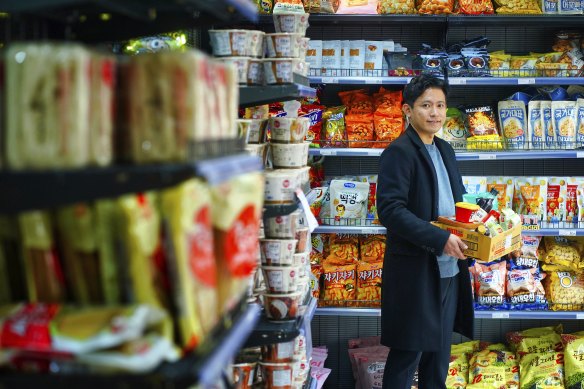
Kimchi
Let’s start with the basics. When you see kimchi on a menu or in a supermarket, it’s most likely referring to baechu-kimchi, the popular red-hued, cabbage kind that tastes salty, sour and a little spicy. It’s made from wombok (Chinese cabbage) soaked in a salty brine, then seasoned and fermented for a few days with gochugaru (chilli powder), garlic, ginger and spring onions (but you’ll often see carrots, sugar, fish sauce and salted seafood like anchovies or shrimp added to the mix).
While kimchi has been around for thousands of years, the red variety was introduced after Portuguese traders brought chilli peppers to Korea in the 1600s. So, if you’d like to try the traditional kind, go for baek-kimchi (white kimchi).
There’s young and old kimchi, and which one you buy is a matter of personal preference: do you prefer crispy and fresh, or deep and flavoursome? Chae prefers fresh kimchi from Hannong Foods ($6.60), grown and made in Australia.
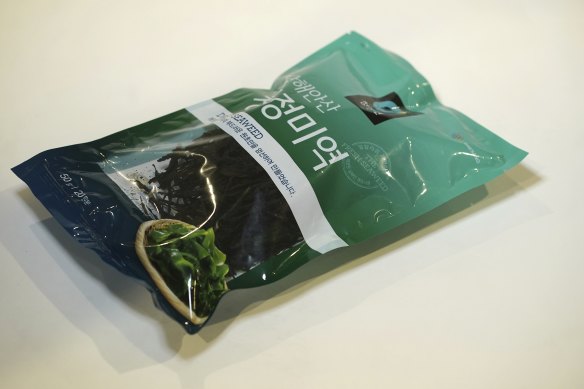
Dried seaweed
“This is one of my favourite ingredients,” Chae says, crouching to rustle through the packets of dried seaweed. “You buy one of these, and it looks like nothing, but when you put it in water, it becomes a lot bigger. This one is 50g, but it’s like 20 serves.”
So, the story goes, people of Korea’s Goyreo dynasty noticed female whales scoffing seaweed after they’d given birth. It became a tradition for Goyreo mothers recovering from childbirth to eat potassium-packed miyeon-guk (seaweed soup), and it’s a typical staple at Korean birthday celebrations.
“Instead of cake, we drink seaweed soup,” Chae says. It’s not on the menu at Doju, but sometimes, if it’s a customer’s birthday, he’ll make them miyeon-guk.
Chae likes the Chungjungwon brand, grown off South Korea’s archipelagos in massive seaweed farms that NASA has spotted from space.
“Korean seaweed isn’t too tough,” Chae says. “When I buy it from the south part of Korea, the seaweed is actually very tender.” But it is slimy, which can be texturally daunting for some. Chae advises soaking the dried seaweed in cold water for about 30 minutes until it quadruples in size, when it can be strained, squeezed, and added to a beefy broth.
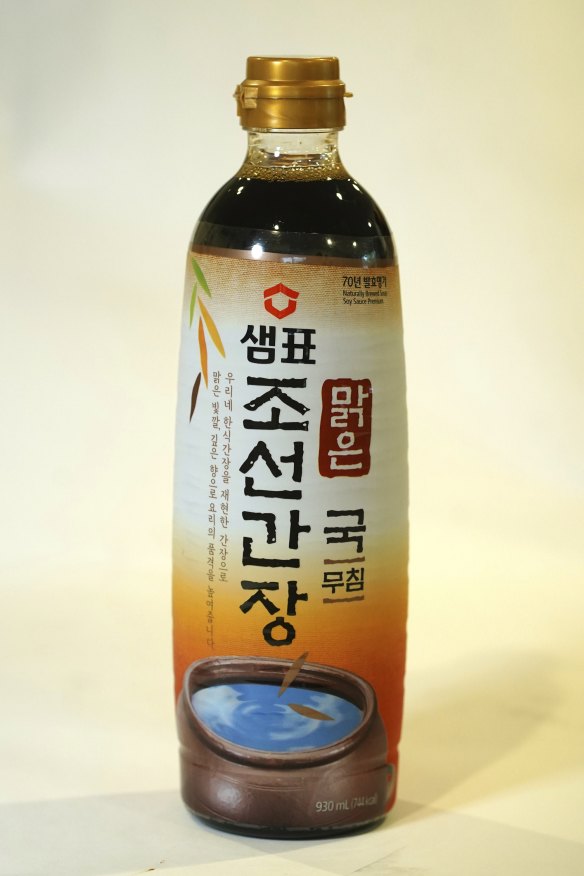
Soy sauce
“Korean soy sauce is different to Japanese or Chinese soy sauce because it’s saltier, not as sweet.” For stir-fries, Chae uses Japanese soy, but when making soup, he’s passionate about using the Korean version. “When you make a delicate light soup, this soy sauce is a key ingredient to add the salty umami depth without the sweetness.”
His tip is to add the soy sauce at the middle or towards the end of the cooking process, rather than at the beginning, or the flavour will become too intense. “If I make a litre of soup, I add two tablespoons,” he says. “Too much, and it makes the soup too brown.”
His chosen brand, Sempio premium, is the Rolls-Royce of soy and leads the pack in Australia. But in Korea, Chae talks of soy sauce masters producing small-batch, handmade offerings. “I tried to import some, but I can’t,” he says. So he’s made his own at Doju, now a year into its ageing process.
To make the sauce, boiled soybeans are shaped into bricks, covered with rice straw to air-dry and naturally ferment, then soaked in salt water for three months. The salty liquid is strained and aged, traditionally for three years, creating a deliciously aromatic, full-bodied liquid. The sauce’s quality is graded by a fermentation index that measures the total nitrogen, achieved using a traditional process and long fermentation period – the higher the nitrogen, the richer the taste.
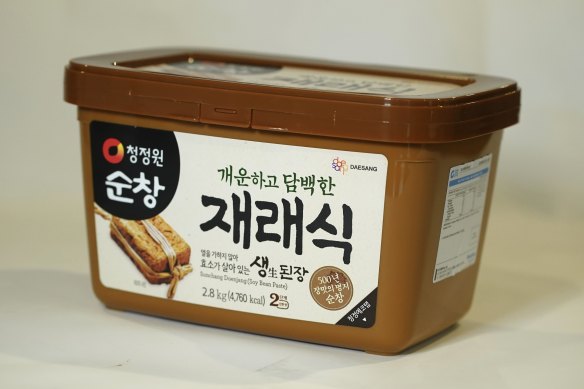
Doenjang (soy bean paste)
Funky, gutsy, earthy, and strong, doenjang is sometimes referred to as “Korean miso”. Chae uses the thick brown paste of fermented soybeans and salt in “basically everything”.
You’ll find it in a brown container, often with a sliding colour scale on the packet – a lighter colour on the gradient indicates mild; if it’s dark brown, expect a ripe, pungent paste, like a good stinky cheese. Chae says his home-made doenjang would rank “strong” but recommends the Daesang Sunchang Doenjang brand as “lighter, good for every dish, and easy to use”.
A byproduct of soy sauce-making, the soft soybean sediment is air-dried and fermented. You can dip raw vegies in it, chuck it on some bibimbap (a Korean rice dish), or pair it with meat, like mustard.
“We always like about 10 side dishes in Korea,” Chae laughs, a favourite being Korean greens amped with the umami hit of doenjang.
“You can use any kind of greens; bok choy, spinach. Blanch the greens, chill in ice water, and squeeze them out. Then you add a bit of doenjang and grated garlic, a bit of soy sauce and a bit of sesame oil. It’s a beautiful side dish that you can just keep it in the fridge and eat it bit by bit.”
A bummer: many commercial doenjangs include wheat flour and won’t be gluten-free.
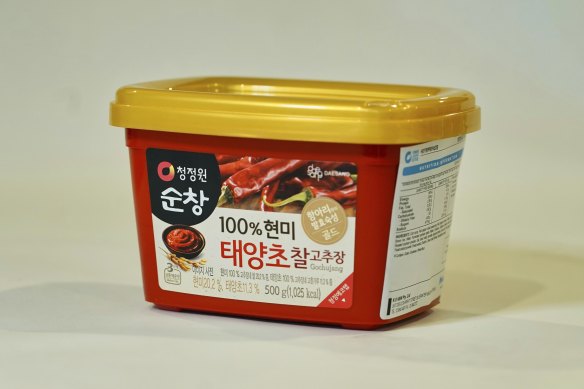
Gochujang (soy bean and chilli paste)
“Actually, they look confusing,” Chae says, facing a wall of gochujang, Korea’s best-loved ingredient, a thick paste of fermented soybean mixed with salt, glutinous rice, and the star of the show, gochugaru, an earthy, spicy chilli that turns the condiment a rich, luscious red.
After careful consideration and close attention to the ingredient list on each tub, Chae chooses Daesang Gochujang, with a spice factor “3”, ranked as “medium hot”. He’s also happy it’s been fermented within the ideal range of six to 12 months.
“We use it for everything, even when we make soup,” Chae says. “We always put a dollop of gochujang on top of rice so you can mix it with everything, and it’s really good on bibimbap.”
It’s addictive stuff, adding a feisty kick to marinades and taking two-minute noodles to the next level. The glutinous rice makes gochujang a winner for thickening stews or broths, and it’s essential in Korea’s classic street food tteokbokki, a spicy wet dish of rice cakes.
Again: most commercial varieties contain gluten.

Plum cheong
“This is my sugar substitute,” Chae says of plum cheong, the tangy, sweet, syrupy extract made from green plums, fermented with sugar for about three months. Studying the label, he tsks over the incorrect English translation of “Japanese apricots”, assuring me they are “100 per cent” plums.
In the timeline of Korean cooking, plum cheong is a more recent addition to the ancient cuisine. Known for its digestive properties, it can be used like a cordial, a simple “tea” mixed with boiling water, or alchemised into wine after a longer fermentation process.
Chae splashes some in his pork belly marinade (see recipe below) to cut through the fat, adding depth and a tart sweetness, or adds it to kimchi. “I don’t like kimchi to be sweet, but I want a light, natural sweetness.”
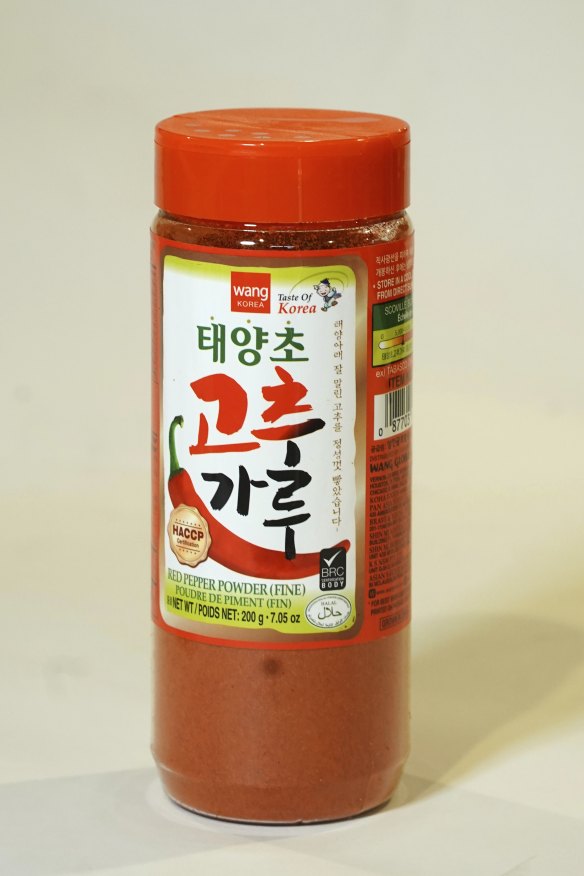
Gochugaru (red chilli flakes)
“I pretty much put this on everything as well,” says Chae, picking up a jar of mild red chilli flakes after weighing up between fine or coarse and checking the Scoville heat scale rating on the back. Wang Red Pepper Powder is a premium brand, the red chillies 100 per cent sun-dried. It has a sweet, slightly smoky fragrance and flavour.
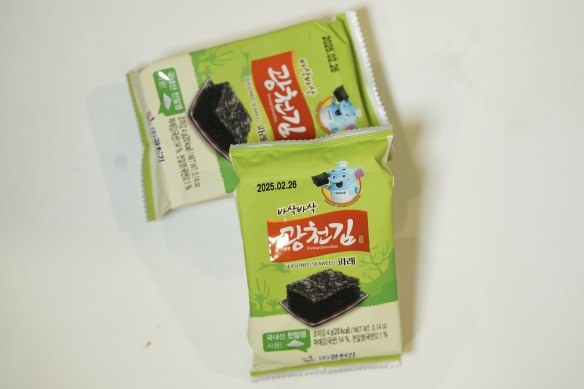
Roasted seaweed
“When I have a beer, I grab one of these instead of chips,” Chae says, gathering a multi-pack of Kimnori Kwangcheonkim Seasoned Seaweed, farmed in the waters of Korea’s southwest. “This is a good one.”
Each thin sheet, like mini parchment paper, is dried and roasted, seasoned with salt and olive oil; other flavours swing from prawn to wasabi to honey butter.
It’s a typical side dish in Korean cuisine, and Chae says it’s common to grab a sheet of dried seaweed and fill it with rice to make a quick roll. He also crumbles it into soups or adds it to bibimbap.
Gochujang-marinated pork belly
This simple and speedy stir-fry uses some of the key ingredients in the Korean pantry.
Ingredients
- 500g pork belly, sliced 2cm-thick
- 15g mirin
- 15g plum cheong
- 10g minced garlic
- 2g black pepper
- 5g grated ginger
- 45g gochujang
- 10g gochugaru (Korean chilli powder)
- 10g sesame oil
- 20g Japanese soy sauce
- ½ a bunch of spring onions
- ½ onion, sliced
- 40g vegetable oil
- steamed rice to serve
Method
- Combine the mirin, plum cheong, garlic, pepper, ginger, gochujang, gochugaru, sesame oil and soy sauce in a large non-reactive bowl, add the pork, toss to coat, and set aside to marinate for at least 1 hour.
- Slice the spring onion, separating the green part (for garnish) from the white part (for cooking).
- To a cold frying pan, add the white part of the spring onion and vegetable oil and gently heat. Once the spring onion gets a good aroma (no brown colour), add the onion and cook for 2 minutes over medium heat.
- Add the pork belly and marinade to the pan. Cook for 15 minutes, stirring occasionally. Add 100ml water, stir again, and reduce the liquid until it is a saucy consistency. Check the seasoning, and serve with steamed rice topped with the reserved sliced (green) spring onion.
Serves 4

